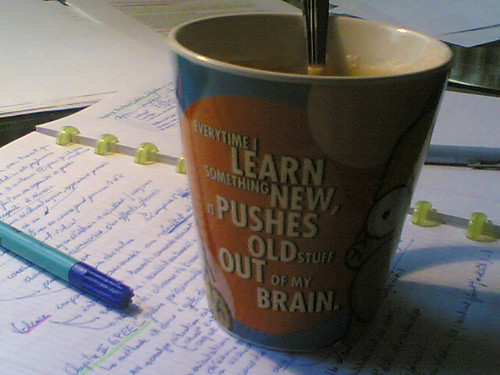Apparently, place does matter!
Place matters
View more presentations from Kenny73
Categories: Geography General
We started off with a picture of a lone bench on the Ballast Bank in Troon (correctly identified by lots of the kids) and discussed the importance of this place to the person the bench is in memory to and also the photographer, who saw a sea view as a fitting epitaph. To the rest of the class, at most, this place is a nice walk and holds no particular importance.
This led on to the phenomenon that is Where the hell is Matt? I thought the class may have seen this before, but they hadn't and were very taken by it, so much so that I think I may have shaped a few future career paths :-) The point of using this clip was to spark curiosity about more than just the funny dances, but the places as well. A discussion followed about which places people would visit and why. What interested me was that, for example, one boy wanted to visit Vegas based totally on the images of that place that have been presented to him through television and other media ('The Hangover', mainly!). Although he felt familiar with Vegas the place, or perhaps because he was 'familiar' with it, he still wanted to experience the place himself. It's easy to forget that places aren't just physical, but have an ambience and a psychological connection too
I then showed the picture from Resolute Bay in Baffin Island and the accompanying quote from Sharon Somerville. The students asked how Sharon and I were in contact, which was a nice story about a place that links us both, The Catlin Arctic Survey Base. We discussed whether remote places lead to a more place aware view of the world. We talked about skype, facebook, msn and all he contacts we had that we had never connected with in their 'place', yet we could describe large parts of, for example, New York city with relative ease. Did our connections lead to a better understanding of place? Is the world so small that we can 'invade' a place without even stepping out the door? In fact, when everything is at the click of a button, is place important at all? The surprising answer to that last question was a resounding 'yes'.
With two exceptions, the class felt that place was vital in understanding world events,understanding connections between places, from something as simple as knowing where it was and how to get there to more cerebral reasons. Over the next couple of slides, a definite feeling from the class that our world view is very much influenced by our 'own places' was emphasised, something that Tony Cassidy had suggested as part of the original discussion. Even for those who felt that place wasn't important, there was a consensus that, watching life in an Indian slum, for example, seemed to repel us, because it wasn't part of our own experience of place. We use our own places as a barometer for everything else in the world around us. It's a constant subconscious comparison.

After this, we had a quick round of Scottish places. As students had clearly indicated the importance of place, it would be interesting to see their mental map of their own country. Using tags, we placed a variety of locations on a blank Scotland on the board. We started with the main settlements, followed up with potentially 'important' Scottish places and finished with three outlying islands. I loved the way this developed. Troon was placed in the Highlands. The rest of the class had an inkling that this was wrong, but it influenced where people put everything else. For instance, Glasgow was placed above Troon, because the person with that tag knew that he would have to travel North to Glasgow from here! As we moved away from the big cities, place knowledge got more and more vague, yet later, some of the types of places I had included were the type of places that students wanted to learn about for their next country study e.g Places with cultural significance. From this, we were able to ascertain a lot of the things that we wanted to be part of our place knowledge and leads us perfectly into this new unit of work with the students as stakeholders in their learning. Perfect! A monster lesson which jumped all over the place but had positive outcomes.







